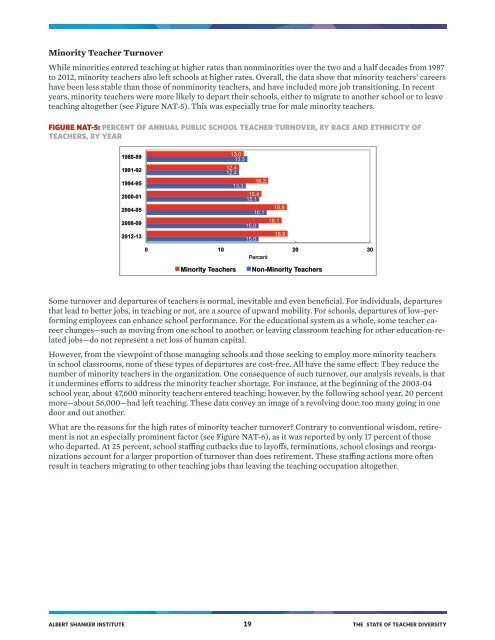TEACHER DIVERSITY
The State of Teacher Diversity_0
The State of Teacher Diversity_0
- No tags were found...
Create successful ePaper yourself
Turn your PDF publications into a flip-book with our unique Google optimized e-Paper software.
Minority Teacher Turnover<br />
While minorities entered teaching at higher rates than nonminorities over the two and a half decades from 1987<br />
to 2012, minority teachers also left schools at higher rates. Overall, the data show that minority teachers’ careers<br />
have been less stable than those of nonminority teachers, and have included more job transitioning. In recent<br />
years, minority teachers were more likely to depart their schools, either to migrate to another school or to leave<br />
teaching altogether (see Figure NAT-5). This was especially true for male minority teachers.<br />
FIGURE NAT-5: PERCENT OF ANNUAL PUBLIC SCHOOL <strong>TEACHER</strong> TURNOVER, BY RACE AND ETHNICITY OF<br />
<strong>TEACHER</strong>S, BY YEAR<br />
1988-89<br />
13.0<br />
13.5<br />
1991-92<br />
12.4<br />
12.4<br />
1994-95<br />
13.3<br />
16.3<br />
2000-01<br />
15.4<br />
15.1<br />
2004-05<br />
16.1<br />
18.8<br />
2008-09<br />
15.0<br />
18.1<br />
2012-13<br />
15.0<br />
18.9<br />
0 10 20 30<br />
Percent<br />
Minority Teachers<br />
Non-Minority Teachers<br />
Some turnover and departures of teachers is normal, inevitable and even beneficial. For individuals, departures<br />
that lead to better jobs, in teaching or not, are a source of upward mobility. For schools, departures of low-performing<br />
employees can enhance school performance. For the educational system as a whole, some teacher career<br />
changes—such as moving from one school to another, or leaving classroom teaching for other education-related<br />
jobs—do not represent a net loss of human capital.<br />
However, from the viewpoint of those managing schools and those seeking to employ more minority teachers<br />
in school classrooms, none of these types of departures are cost-free. All have the same effect: They reduce the<br />
number of minority teachers in the organization. One consequence of such turnover, our analysis reveals, is that<br />
it undermines efforts to address the minority teacher shortage. For instance, at the beginning of the 2003-04<br />
school year, about 47,600 minority teachers entered teaching; however, by the following school year, 20 percent<br />
more—about 56,000—had left teaching. These data convey an image of a revolving door: too many going in one<br />
door and out another.<br />
What are the reasons for the high rates of minority teacher turnover? Contrary to conventional wisdom, retirement<br />
is not an especially prominent factor (see Figure NAT-6), as it was reported by only 17 percent of those<br />
who departed. At 25 percent, school staffing cutbacks due to layoffs, terminations, school closings and reorganizations<br />
account for a larger proportion of turnover than does retirement. These staffing actions more often<br />
result in teachers migrating to other teaching jobs than leaving the teaching occupation altogether.<br />
ALBERT SHANKER INSTITUTE 19 THE STATE OF <strong>TEACHER</strong> <strong>DIVERSITY</strong>


